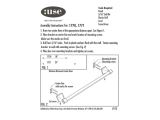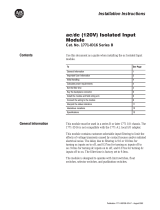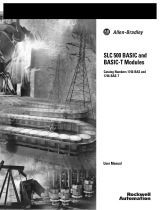Page is loading ...

ID
Installation Data
TTL Input Module
Cat. No. 1771IGD
Installation Instructions
This document provides information on:
important pre-installation considerations
power supply requirements
initial handling
installing the module
using the indicators for troubleshooting
replacing the fuse
module specifications
You can use this module in a Series A or B 1771-A1B, -A2B, -A3B,
-A3B1, and -A4B chassis. The module is also compatible in a 1771-AM1
or -AM2 I/O chassis.
You can use any TTL device that meets the output logic level specification
of -0.2V dc to +0.8V dc (low), and 2.0V dc to 5.25V dc (high).
This module contains input filtering to limit the effects of voltage
transients caused by contact bounce and/or radiated electrical noise.
The delay due to filtering is less than 1ms.
For maximum noise immunity, the output of the TTL device should have a
pull-up resistor of 1k ohm (typical). Add an external pull-up resistor to the
output terminals of the device, if necessary. If you add a pull-up resistor, be
sure the TTL device maintains the low state requirement of -0.2V dc to
+0.8V dc with the increased load.
The TTL module requires power from two sources: the I/O chassis
backplane, and a +5V dc power supply that you provide for transmission of
TTL signals.
To The Installer
Preinstallation
Considerations
Power Requirements

TTL Input Module
Cat. No. 1771IGD
Installation Instructions
2
Backplane
The TTL module receives its power through the 1771 I/O chassis
backplane from the chassis power supply. The module requires 130mA
from the output of this supply. Add this to the requirements of all other
modules in the I/O chassis to prevent overloading the chassis backplane
and/or backplane power supply.
Customer Supply
You must provide a separate +5(+
0.25)V dc power supply for the TTL
inputs of the module and for your TTL output devices. Your module
requires 380mA from the output of your supply. Ripple should not exceed
50mV peak to peak.
The TTL input module is shipped in a static-shielded bag to guard against
electrostatic discharge damage. Observe the following precautions when
handling the module.
Electrostatic Discharge Damage
ATTENTION: Under some conditions, electrostatic discharge
can degrade performance or damage the module. Observe the
following precautions to guard against electrostatic damage.
Wear an approved wrist strap grounding device, or touch a grounded
object to discharge yourself before handling the module.
Do not touch the backplane connector or connector pins.
If you configure or replace internal components, do not touch other
circuit components inside the module. If available, use a static-free
work station.
When not in use, keep the module in its static-shielded bag.
In this section, we tell you how to set the logic level jumper, key your I/O
chassis, install your module and make your wiring connections.
Selecting the Logic Level
Your module is preset to the positive-logic level. Use the following table to
choose between the two logic levels:
If you choose: Then: Jumper Position
HIGH = TRUE logic (positive) 2.0 to 5.25V dc corresponds to logic ``1" (on) Toward rear of module
LOW = TRUE logic (negative) -0.2 to 0.8V dc corresponds to logic ``1" (on) Toward front of module
Note: Selecting positive logic automatically enables the HIGH (positive logic) indicator.
Initial Handling
Installing Your Module

TTL Input Module
Cat. No. 1771IGD
Installation Instructions
3
You select high-true or low-true using the jumper accessible through a slot
at the top of the module.
1. Locate the jumper in the slot at the top edge of the module.
2. Use tweezers to position the jumper as required for your application.
When on front 2 pins, negative logic
selected (low = true).
TTL Input Module
When on rear 2 pins, positive logic
selected (high = true).
10449I
TTL Logic Level Selection Jumper Assembly
Keying Your I/O Chassis
Use the plastic keying bands, shipped with each I/O chassis, to key the I/O
slots to accept only this type of module.
The module circuit board is slotted in two places on the rear edge. The
position of the keying bands on the backplane connector must correspond
to these slots to allow insertion of the module. You can key any connector
in an I/O chassis to receive this module except for the left-most connector
reserved for adapter or processor modules. Place keying bands between the
following numbers labeled on the upper backplane connector:
Between 16 and 18
Between 24 and 26
You can change the position of these keys if system redesign and rewiring
makes insertion of a different module necessary.
Installing the Input Module
To install the TTL input module in your 1771 I/O chassis, follow the steps
listed below.

TTL Input Module
Cat. No. 1771IGD
Installation Instructions
4
ATTENTION: Remove power from the 1771 I/O chassis
backplane and wiring arm before removing or installing an
I/O module.
Failure to remove power from the backplane or field wiring
arm could cause module damage, degradation of
performance,
or injury.
Failure to remove power from the backplane could cause
injury or equipment damage due to possible unexpected
operation.
1. Turn off power to the I/O chassis.
2. Place the module in the plastic tracks on the top and bottom of the
slot that guides the module into position.
3. Do not force the module into its backplane connector. Apply firm,
even pressure on the module to seat it properly.
4. Secure the module’s position by doing the following:
with a Series A chassis, snap the chassis latch over the top of the
module
with a Series B chassis, pull down the locking bar
5. Connect the field wiring arm to the input module.
Connecting Wiring to the Input Module
Connect wiring to the input module using the field wiring arm (cat. no.
1771-WH) shipped with the module (shown in the connection diagram
below). Make your connections as follows:
1. Attach the field wiring arm to the pivot bar on the bottom of the I/O chassis.
2. Pivot the wiring arm upward and push it into the module until the wiring
arm clicks into position. The field wiring arm is designed to let you install
and remove the module without disconnecting the wires.
ATTENTION: Do not apply ac or reverse dc voltage to
module terminals. Circuitry at the input of module may
be damaged.

TTL Input Module
Cat. No. 1771IGD
Installation Instructions
5
3. Separate the shielded cables from wiring that radiates electrical noise.
Refer to category 2, low power dc I/O lines, in publication 1770-4.1,
‘‘Programmable Controller Wiring and Grounding Guidelines”.
4. Prepare the cable for grounding by doing the following:
Remove a length of cable
jacket from the Belden 8761
cable.
Pull the foil shield and bare
drain wire from the insulated
wires.
Bare
drain
wire
Insulated
wires
Foil
shield
Twist the foil shield and drain
wire together to form a single
strand.
Attach a ground lug.
20104
Belden
8761 Cable
5. Ground the single strand (at the ground lug end) to the grounding
stud on the I/O chassis or by using single-point grounding.
19480
When you connect grounding conductors to the I/O chassis
grounding stud, place a star washer under the first lug, then
place a nut with captive lock washer on top of each ground lug.
Grounding Stud
1
Use
the cup washer if crimpon lugs are not used.
Chassis Ground Singlepoint Grounding
Ground Lug
Nut
Ground Lug
1
Star
Washer
I/O Chassis Side Plate
Nut and Captive
Washer
Externaltooth Washers
#10 Threadforming screw
19923

TTL Input Module
Cat. No. 1771IGD
Installation Instructions
6
6. You must connect both ends of the insulated signal return wire in
each transmission cable as follows:
connect one end to the dc common terminal of your +5V dc power
supply
connect the other end to the dc common terminal of the field
wiring arm
dc common
+5V dc
Input 00
Input 01
Input 02
Input 03
Input 04
Input 05
Input 06
Input 07
Customer
Power Supply
+5V dc
+
-
Ground cable shield at the chassis
grounding stud or by using single
point grounding
2
3
3
2
2
3
TTL Devices must have opencollector outputs.
Internal or external pullup resistor (1K ohm typical).
(See applicable codes and laws.)
Input 10
Input 11
Input 12
Input 13
Input 14
Input 15
Input 16
Input 17
+5V dc
+5V dc
+5V dc
(Actual wiring runs in this direction.)
A
B
C
D
00
01
02
03
04
05
06
07
10
11
12
13
14
15
16
17
E
10450I
1
1
You can make this connection to terminal A, B, C or D.
Field Wiring Arm
Cat. No. 1771WH
7. Connect TTL output devices using Belden 8761 shielded cable as
shown in the connection diagram. Do not exceed 50 cable feet for any
output device. Connect the insulated wires to their respective
terminals on the field wiring arm.
Driving Inputs with Outputs
Input terminals of the TTL input module (cat. no. 1771-IGD) may be
directly driven by the outputs of a TTL output module (cat. no.
1771-OGD). Connect the cable shield between modules at one end only.

TTL Input Module
Cat. No. 1771IGD
Installation Instructions
7
The front panel of your module contains 18 status indicators (Figure 1).
The green top indicator is labeled ‘‘ACTIVE.” This indicator is on when
the fuse is good. The green bottom indicator, when on, indicates you
selected high-true logic. When off, it indicates you selected low-true logic.
Each of the 16 red status indicators light when their corresponding input
terminal senses TTL voltages in the true state.
Figure 1
Status
Indicators
ACTIVE
00
01
02
03
04
05
06
07
10
11
12
13
14
15
16
17
Module Active Indicator (green)
00 to 17 Status Indicators (red)
HIGH
Positive Logic Indicator (green)
10451I
To replace a blown fuse, proceed as follows:
ATTENTION: Remove power from the 1771 I/O chassis
backplane and field wiring arm before removing or installing an
I/O module.
Failure to remove power from the backplane or field wiring
arm could cause module damage, degradation of
performance, or injury.
Failure to remove power from the backplane could cause
injury or equipment damage due to possible unexpected
operation.
1. Turn off power to the chassis.
2. Remove the module from the I/O chassis.
3. Remove the blown fuse from the fuse holder (accessible through the
slot in the side cover), and replace with a 0.5A, 250V normal
blow fuse.
4. Reinsert module into the I/O chassis.
5. Turn on power to the chassis.
Interpreting the Status
Indicators
Replacing the Fuse

Specifications
TTL Input Module
Cat. No. 1771IGD
Installation Instructions
8
Inputs per Module
16
Module Location Series A or B 1771A1B, A2B, A3B,
A3B1, or A4B I/O chassis. Other locations
include 1771AM1, and AM2 I/O chassis.
Input Voltage Rating
HIGH = TRUE
LOW = TRUE
ON: 2.0 to 5.25V dc
OFF: -0.2 to +0.8V dc
ON: -0.2 to +0.8V dc
OFF: 2.0 to 5.25V dc
Customer Supply Voltage 5.0V dc (+0.25V)
50mV peaktopeak ripple max.
Customer Current Sink Requirements 7mA maximum (source per input)
0.8mA maximum (sink per input)
Customer Supply Current per Module 380mA max.
Input Signal Delay Less than 1ms
Power Dissipation 2.7 Watts (max.); 0.4 Watts (min.)
Thermal Dissipation 9.2 BTU/hr (max.); 1.4 BTU/hr (min.)
Backplane Current 130mA max.
Isolation Voltage Tested at 1500V ac (rms) for 1 second
Environmental Conditions
Operational Temperature
Storage Temperature
Relative Humidity
0
o
to 60
o
C (32
o
to 140
o
F)
-40
o
to 85
o
C (-40
o
to 185
o
F)
5 to 95% (without condensation)
Fuse 0.5A 250V normal blow
Conductors Wire Size
Cable
Category
14 gauge stranded maximum
3/64 inch insulation maximum
Shielded (Belden 8761)
2
1
Keying Between 16 and 18
Between 24 and 26
Field Wiring Arm Catalog Number 1771WH
Wiring Arm Screw Torque 79 inchpounds
1
Refer
to publication 17704.1, Programmable Controller Wiring and Grounding Guidelines.
With major offices worldwide.
Algeria •
Argentina
•
Australia
•
Austria
•
Bahrain
• Belgium • Brazil •
Bulgaria
•
Canada
• Chile •
China, PRC
•
Colombia
• Costa Rica •
Croatia
•
Cyprus
• Czech
Republic
•
Denmark
•
Ecuador
• Egypt • El Salvador • Finland • France •
Germany
•
Greece
•
Guatemala
•
Honduras
•
Hong Kong
•
Hungary
• Iceland •
India
•
Indonesia
•
Israel
• Italy • Jamaica •
Japan
•
Jordan
•
Korea
•
Kuwait
•
Lebanon
• Malaysia • Mexico •
New Zealand
•
Norway
• Oman • Pakistan •
Peru
• Philippines
•
Poland
•
Portugal
•
Puerto Rico
•
Qatar
•
Romania
•
Russia-CIS
•
Saudi Arabia
•
Singapore
• Slovakia • Slovenia •
South Africa, Republic
• Spain •
Switzerland
•
T
aiwan
• Thailand •
The Netherlands
• T
urkey
•
United Arab Emirates
•
United Kingdom
•
United States
•
Uruguay
• V
enezuela
• Yugoslavia
W
orld Headquarters, AllenBradley
, 1201 South Second Street, Milwaukee, WI 53204 USA, T
el: (1) 414 3822000 Fax: (1) 414 3824444
AllenBradley has been helping its customers improve productivity and quality for 90 years.
AB designs, manufactures and supports a broad range of control and automation products
worldwide. They include logic processors, power and motion control devices, manmachine
interfaces and sensors. AllenBradley is a subsidiary of Rockwell International, one of the
world's leading technology companies.
Publication
17712.178 January 1994
Supersedes
Publication 17712.131 - May 1989
PN
95510768
Copyright
1994 AllenBradley Company
, Inc. Printed in USA
/






